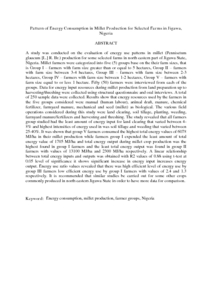Citation
Abubakar, Mohammed Shu'aibu and Ahmad, Desa
(2010)
Pattern of Energy Consumption in Millet Production for Selected Farms in Jigawa, Nigeria.
Australian Journal of Basic and Applied Sciences, 4 (4).
pp. 665-672.
ISSN 1991-8178
Abstract
A study was conducted on the evaluation of energy use patterns in millet (Pennisetum
glaucum [L.] R. Br.) production for some selected farms in north eastern part of Jigawa State, Nigeria.
Millet farmers were categorized into five (5) groups base on the their farm sizes, that is Group I –
farmers with farm size greater than or equal to 5 hectares, Group II – farmers with farm size between
3-4 hectares, Group III – farmers with farm size between 2-3 hectares, Group IV – farmers with farm
size between 1-2 hectares, Group V – farmers with farm size equal to or less 1 hectare. Fifty (50)
farmers were interviewed from each of the groups. Data for energy input resources during millet
production from land preparation up to harvesting/threshing were collected using structural
questionnaire and oral interviews. A total of 250 sample data were collected. Results show that energy
resources used by the farmers in the five groups considered were manual (human labour), animal
draft, manure, chemical fertilizer, farmyard manure, mechanical and seed (millet) as biological. The
various field operations considered during this study were land clearing, soil tillage, planting, weeding,
farmyard manure/fertilizers and harvesting and threshing. The study revealed that all farmers group
studied had the least amount of energy input for land clearing that varied between 4-8% and highest
intensities of energy used in was soil tillage and weeding that varied between 25-40%. It was shown
that group V farmers consumed the highest total energy values of 6078 MJ/ha in their millet
production while farmers group I expended the least amount of total energy value of 1705 MJ/ha and
total energy output during millet crop production was the highest found in group I farmers and the
least total energy output was found in group II farmers with values of 13100 MJ/ha and 2300 MJ/ha
respectively. A linear relationship between total energy inputs and outputs was obtained with R2 values
of 0.88 using t-test at 0.05 level of significance it shows significant increase in energy input increases
energy output. Energy use ratio values revealed that there was high efficient level of energy use by
group III farmers low efficient energy use by group I farmers with values of 2.4 and 1.3 respectively.
It is recommended that similar studies be carried out for some other crops commonly produced in
north eastern Jigawa State in order to have more data for comparison.
Download File
![[img]](http://psasir.upm.edu.my/9971/1.hassmallThumbnailVersion/Pattern%20of%20Energy%20Consumption%20in%20Millet%20Production%20for%20Selected%20Farms%20in%20Jigawa.pdf)  Preview |
|
PDF (Abstract)
Pattern of Energy Consumption in Millet Production for Selected Farms in Jigawa.pdf
Download (187kB)
| Preview
|
|
Additional Metadata
Actions (login required)
 |
View Item |

